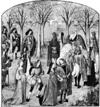- pavane
-
/peuh vahn", -van"/; Fr. /pann vannn"/, n., pl. pavanes /peuh vahnz", -vanz"/; Fr. /pann vannn"/.1. a stately dance dating from the 16th century.2. the music for this dance.
* * *
Stately court dance introduced from southern Europe into England in the 16th century.The dance, consisting of forward and backward steps to music in duple time, was originally used to open ceremonial balls; later its steps became livelier and it came to be paired with the quick galliard in triple time. Reproduced by permission of the British Library
Reproduced by permission of the British Library* * *
▪ dance(probably from Italian padovana, “Paduan”), majestic processional dance of the 16th- and 17th-century European aristocracy. Until about 1650 the pavane opened ceremonial balls and was used as a display of elegant dress. Adapted from the basse danse, an earlier court dance, the pavane presumably traveled from Italy to France and England by way of Spain; in southern Spain it was performed in churches on solemn occasions.The pavane's basic movement, to music in 2/2 or 4/4 time, consisted of forward and backward steps; the dancers rose onto the balls of their feet and swayed from side to side. A column of couples circled the ballroom, and the dancers occasionally sang. By about 1600, livelier steps like the fleuret (a brief lift of each foot before a step) made the dance less pompous. The pavane was customarily followed by its afterdance, the vigorous galliard. The passamezzo was a livelier Italian contemporary of the pavane.The paired dances, pavane and galliard, were a forerunner of the instrumental dance suites of the 17th century, and pavanes appear in a few early suites—e.g., the padouanas in some suites of Johann Hermann Schein. Later composers occasionally used the pavane as an instrumental piece; e.g., Fauré (Pavane for Orchestra) and Ravel (Pavane for a Dead Princess).* * *
Universalium. 2010.
